Prediction of Occupant Behavior toward Natural Ventilation in Japanese Dwellings: Machine Learning Models and Feature Selection
Abstract
1. Introduction
2. Methods
2.1. Survey
2.1.1. Survey Overview
2.1.2. Thermal Environment Survey
2.1.3. Subjective Vote Survey
2.1.4. Thermal Indices
2.2. Analysis Method
2.3. Prediction Model Used for Binary Classification
2.4. Hyperparameter Tuning
2.5. Performance Evaluation
3. Results and Discussion
3.1. Basic Aggregation
3.2. Analysis Using All Variables
3.3. Analysis Using Feature Selection
3.4. Analysis Using Thermal Indices of Room
3.5. Analysis Using Experiential Temperature Thermal Factors
3.6. Analysis Using Outdoor Thermal Indices
3.7. Analysis Using Outdoor Environment Thermal Factors
3.8. Analysis Using Thermal Indices Representative of Indoor and Outdoor Environments
3.9. Analysis of Representative Indoor Thermal Indices and Cooling
3.10. Investigation of Optimal Features Describing Window-Opening/Closing Behavior
3.11. Comparison with Previous Studies
4. Conclusions
Author Contributions
Funding
Institutional Review Board Statement
Informed Consent Statement
Data Availability Statement
Acknowledgments
Conflicts of Interest
References
- Huovila, P.; Ala-Juusela, M.; Melchert, L.; Pouffary, S.; Cheng, C.C.; Ürge-Vorsatz, D.; Koeppel, S.; Svenningsen, N.; Graham, P. Buildings and Climate Change: Summary for Decision Makers; Sustainable United Nations; United Nations Environment Programme: Nairobi, Kenya, 2009. [Google Scholar]
- Congedo, P.M.; Baglivo, C.; Seyhan, A.K.; Marchetti, R. Worldwide dynamic predictive analysis of building performance under long-term climate change conditions. J. Build. Eng. 2021, 42, 103057. [Google Scholar] [CrossRef]
- Carlucci, S.; Causone, F.; Biandrate, S.; Ferrando, M.; Moazami, A.; Erba, S. On the impact of stochastic modeling of occupant behavior on the energy use of office buildings. Energy Build. 2021, 246, 111049. [Google Scholar] [CrossRef]
- Du, J.; Pan, W. Diverse occupant behaviors and energy conservation opportunities for university student residences in Hong Kong. Build. Environ. 2021, 195, 107730. [Google Scholar] [CrossRef]
- Clevenger, C.; Haymaker, J.; Jalili, M. Demonstrating the impact of the occupant on building performance. J. Comput. Civ. Eng. 2014, 28, 99–102. [Google Scholar] [CrossRef]
- Ioannou, A.; Itard, L.C.M. Energy performance and comfort in residential buildings: Sensitivity for building parameters and occupancy. Energy Build. 2015, 92, 216–233. [Google Scholar] [CrossRef]
- Sun, K.; Hong, T. A simulation approach to estimate energy savings potential of occupant behavior measures. Energy Build. 2017, 136, 43–62. [Google Scholar] [CrossRef]
- Wang, L.; Greenberg, S. Window operation and impacts on building energy consumption. Energy Build. 2015, 92, 313–321. [Google Scholar] [CrossRef]
- Rijal, H.B.; Humphreys, M.A.; Nicol, J.F. Development of a window opening algorithm based on adaptive thermal comfort to predict occupant behavior in Japanese dwellings. Jpn. Archit. Rev. 2018, 1, 310–321. [Google Scholar] [CrossRef]
- Andersen, R.; Fabi, V.; Toftum, J.; Corgnati, S.P.; Olesen, B.W. Window opening behaviour modelled from measurements in Danish dwellings. Build. Environ. 2013, 69, 101–113. [Google Scholar] [CrossRef]
- Shi, S.; Zhao, B. Occupants’ interactions with windows in 8 residential apartments in Beijing and Nanjing, China. Build. Simul. 2016, 9, 221–231. [Google Scholar] [CrossRef]
- Jeong, B.; Jeong, J.-W.; Park, J.S. Occupant behavior regarding the manual control of windows in residential buildings. Energy Build. 2016, 127, 206–216. [Google Scholar] [CrossRef]
- Jones, R.V.; Fuertes, A.; Gregori, E.; Giretti, A. Stochastic behavioural models of occupants’ main bedroom window operation for UK residential buildings. Build. Environ. 2017, 118, 144–158. [Google Scholar] [CrossRef]
- Shi, S.; Li, H.; Ding, X.; Gao, X. Effects of household features on residential window opening behaviors: A multilevel logistic regression study. Build. Environ. 2020, 170, 106610. [Google Scholar] [CrossRef]
- Fabi, V.; Andersen, R.K.; Corgnati, S. Verification of stochastic behavioural models of occupants’ interactions with windows in residential buildings. Build. Environ. 2015, 94, 371–383. [Google Scholar] [CrossRef]
- Lai, D.; Jia, S.; Qi, Y.; Liu, J. Window-opening behavior in Chinese residential buildings across different climate zones. Build. Environ. 2018, 142, 234–243. [Google Scholar] [CrossRef]
- Zhang, Y.; Barrett, P. Factors influencing the occupants’ window opening behaviour in a naturally ventilated office building. Build. Environ. 2012, 50, 125–134. [Google Scholar] [CrossRef]
- Rijal, H.B.; Tuohy, P.; Humphreys, M.A.; Nicol, J.F.; Samuel, A.; Clarke, J. Using results from field surveys to predict the effect of open windows on thermal comfort and energy use in buildings. Energy Build. 2007, 39, 823–836. [Google Scholar] [CrossRef]
- Herkel, S.; Knapp, U.; Pfafferott, J. Towards a model of user behaviour regarding the manual control of windows in office buildings. Build. Environ. 2008, 43, 588–600. [Google Scholar] [CrossRef]
- Yun, G.Y.; Steemers, K. Time-dependent occupant behaviour models of window control in summer. Build. Environ. 2008, 43, 1471–1482. [Google Scholar] [CrossRef]
- Haldi, F.; Robinson, D. On the behaviour and adaptation of office occupants. Build. Environ. 2008, 43, 2163–2177. [Google Scholar] [CrossRef]
- Deme Belafi, Z.; Naspi, F.; Arnesano, M.; Reith, A.; Revel, G.M. Investigation on window opening and closing behavior in schools through measurements and surveys: A case study in Budapest. Build. Environ. 2018, 143, 523–531. [Google Scholar] [CrossRef]
- Fathi, S.; Srinivasan, R.; Fenner, A.; Fathi, S. Machine learning applications in urban building energy performance forecasting: A systematic review. Renew. Sustain. Energy Rev. 2020, 133, 110287. [Google Scholar] [CrossRef]
- Wang, Z.; Srinivasan, R. A review of artificial intelligence-based building energy use prediction: Contrasting the capabilities of single and ensemble prediction models. Renew. Sustain. Energy Rev. 2016, 75, 796–808. [Google Scholar] [CrossRef]
- Tardioli, G.; Kerrigan, R.; Oates, M.; O’Donnell, J.; Finn, D. Data driven approaches for prediction of building energy consumption at urban level. Energy Procedia 2015, 78, 3378–3383. [Google Scholar] [CrossRef]
- Wei, Y.; Zhang, X.; Shi, Y.; Xia, L.; Pan, S.; Wu, J.; Han, M.; Zhao, X. A review of data-driven approaches for prediction and classification of building energy consumption. Renew. Sustain. Energy Rev. 2018, 82, 1027–1047. [Google Scholar] [CrossRef]
- Pham, A.-D.; Ngo, N.-T.; Ha Truong, T.T.; Huynh, N.-T.; Truong, N.-S. Predicting energy consumption in multiple buildings using machine learning for improving energy efficiency and sustainability. J. Clean. Prod. 2020, 260, 121082. [Google Scholar] [CrossRef]
- Robinson, C.; Dilkina, B.; Hubbs, J.; Zhang, W.; Guhathakurta, S.; Brown, M.A.; Pendyala, R.M. Machine learning approaches for estimating commercial building energy consumption. Appl. Energy 2017, 208, 889–904. [Google Scholar] [CrossRef]
- Li, K.; Xie, X.; Xue, W.; Dai, X.; Chen, X.; Yang, X. A hybrid teaching-learning artificial neural network for building electrical energy consumption prediction. Energy Build. 2018, 174, 323–334. [Google Scholar] [CrossRef]
- Olu-Ajayi, R.; Alaka, H.; Sulaimon, I.; Sunmola, F.; Ajayi, S. Building energy consumption prediction for residential buildings using deep learning and other machine learning techniques. J. Build. Eng. 2022, 45, 103406. [Google Scholar] [CrossRef]
- Kayoko, H. Thermal insulation of clothing. J. Textile Mach. Soc. Japan 1982, 35, P358–P364. [Google Scholar]
- Japan Meteorological Agency. Available online: https://www.data.jma.go.jp/obd/stats/etrn/ (accessed on 27 June 2022).
- American National Standards Institute; American Society of Heating, Refrigerating and Air-Conditioning Engineers. ANSI/ASHRAE Standard 55-2020: Thermal Environmental Conditions for Human Occupancy; American Society of Heating, Refrigerating and Air Conditioning Engineers, Inc.: Atlanta, GA, USA, 2020. [Google Scholar]
- American Society of Heating, Refrigerating and Air Conditioning Engineers. ASHRAE Handbook—Fundamentals 2017 Chapter 9: Thermal Comfort; American Society of Heating, Refrigerating and Air Conditioning Engineers, Inc.: Atlanta, GA, USA, 2017. [Google Scholar]
- RapidMiner|Amplify the Impact of Your People, Expertise & Data, RapidMiner. Available online: https://rapidminer.com/ (accessed on 27 June 2022).
- Cheung, F.K.T.; Skitmore, M. Application of cross validation techniques for modelling construction costs during the very early design stage. Build. Environ. 2006, 41, 1973–1990. [Google Scholar] [CrossRef][Green Version]
- van Herwerden, D.; O’Brien, J.W.; Choi, P.M.; Thomas, K.V.; Schoenmakers, P.J.; Samanipour, S. Naive Bayes classification model for isotopologue detection in LC-HRMS data. Chemom. Intell. Lab. Syst. 2022, 223, 104515. [Google Scholar] [CrossRef]
- Domingos, P. A few useful things to know about machine learning. Commun. ACM 2012, 55, 78–87. [Google Scholar] [CrossRef]
- Wang, Z.; Wang, Y.; Zeng, R.; Srinivasan, R.S.; Ahrentzen, S. Random Forest based hourly building energy prediction. Energy Build. 2018, 171, 11–25. [Google Scholar] [CrossRef]
- What Is the Difference between Bagging and Boosting? Quantdare, 2016. Available online: https://quantdare.com/what-is-the-difference-between-bagging-and-boosting/ (accessed on 27 June 2022).
- Bienvenido-Huertas, D.; Rubio-Bellido, C.; Pérez-Ordóñez, J.L.; Moyano, J. Optimizing the evaluation of thermal transmittance with the thermometric method using multilayer perceptrons. Energy Build. 2019, 198, 395–411. [Google Scholar] [CrossRef]
- Rasmussen, C.D. Gaussian processes in machine learning. In Revised Lectures; Bousquet, O., von Luxburg, U., Rätsch, G., Eds.; Springer: Berlin/Heidelberg, Germany, 2004; pp. 63–71. [Google Scholar]
- Noble, W.S. What is a support vector machine? Nat. Biotechnol. 2006, 24, 1565–1567. [Google Scholar] [CrossRef]
- Chan, S.Y.; Chau, C.K. Development of artificial neural network models for predicting thermal comfort evaluation in urban parks in summer and winter. Build. Environ. 2019, 164, 106364. [Google Scholar] [CrossRef]
- Goodfellow, I.; Bengio, Y.; Courville, A. Deep Learning; MIT Press: Cambridge, MA, USA, 2016. [Google Scholar]
- Payet, M.; David, M.; Lauret, P.; Amayri, M.; Ploix, S.; Garde, F. Modelling of occupant behaviour in non-residential mixed-mode buildings: The distinctive features of tropical climates. Energy Build. 2022, 259, 111895. [Google Scholar] [CrossRef]
- Shrestha, M.; Rijal, H.B.; Kayo, G.; Shukuya, M. A field investigation on adaptive thermal comfort in school buildings in the temperate climatic region of Nepal. Build. Environ. 2021, 190, 107523. [Google Scholar] [CrossRef]
- Psomas, T.; Fiorentini, M.; Kokogiannakis, G.; Heiselberg, P. Ventilative cooling through automated window opening control systems to address thermal discomfort risk during the summer period: Framework, simulation and parametric analysis. Energy Build. 2017, 153, 18–30. [Google Scholar] [CrossRef]
- Haldi, F.; Robinson, D. Interactions with window openings by office occupants. Build. Environ. 2009, 44, 2378–2395. [Google Scholar] [CrossRef]
- Markovic, R.; Grintal, E.; Wölki, D.; Frisch, J.; van Treeck, C. Window opening model using deep learning methods. Build. Environ. 2018, 145, 319–329. [Google Scholar] [CrossRef]


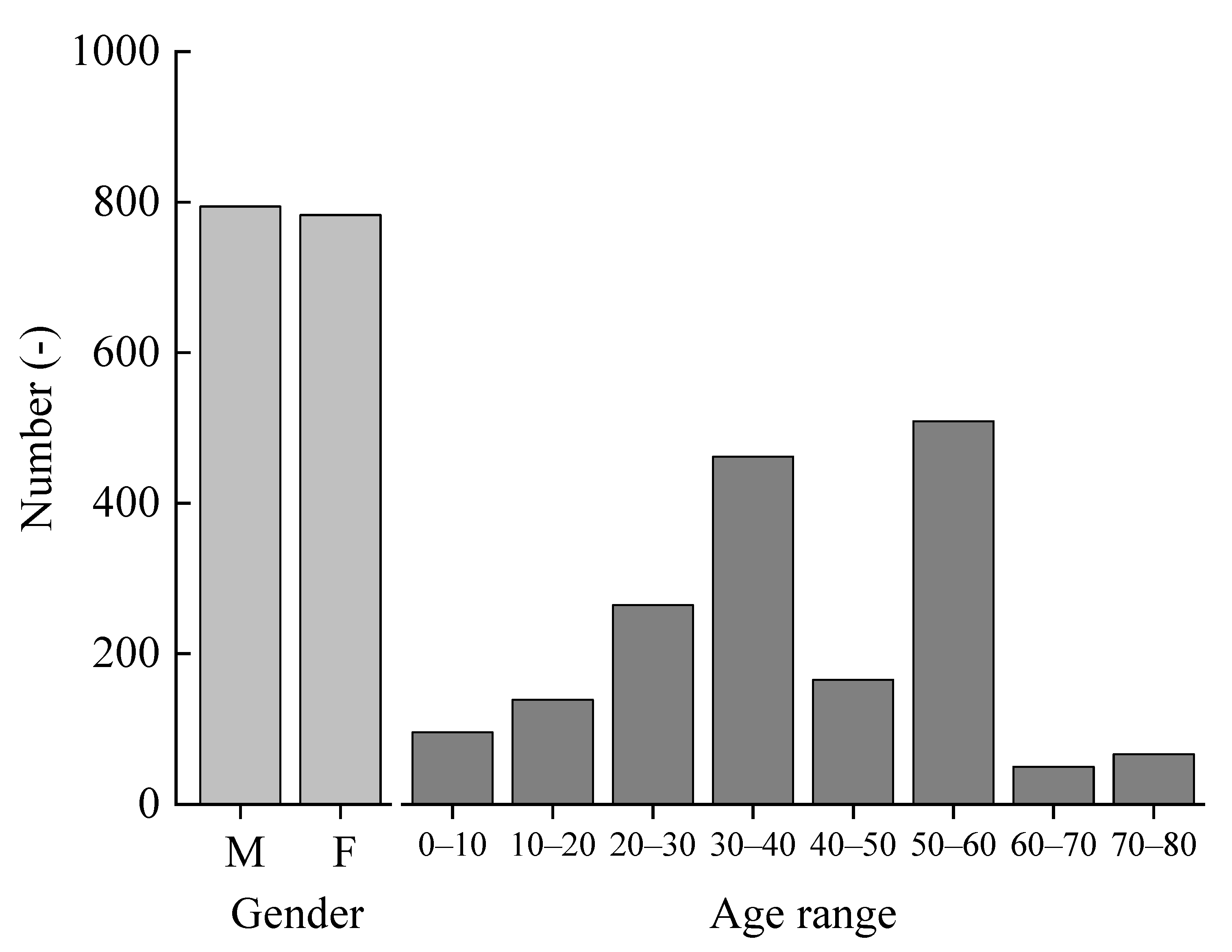

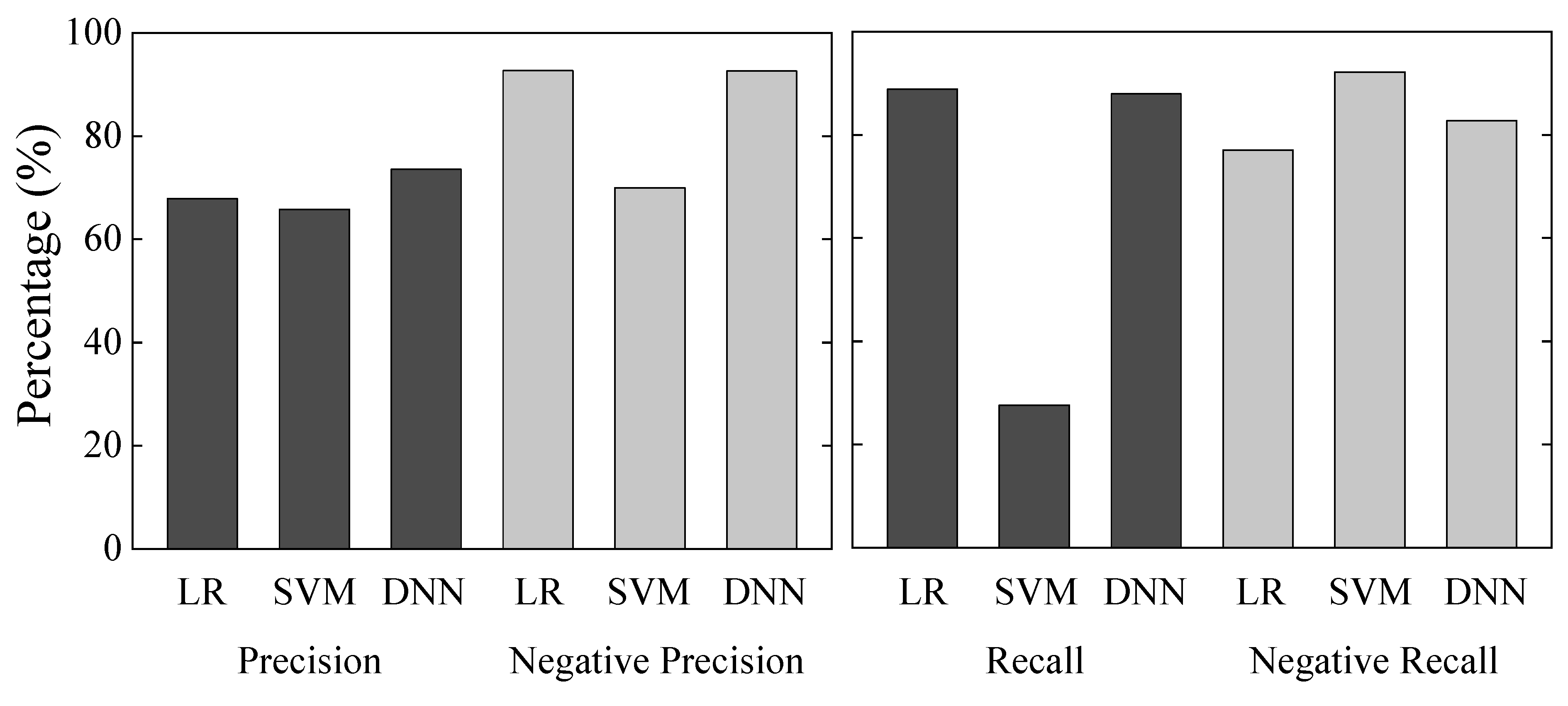


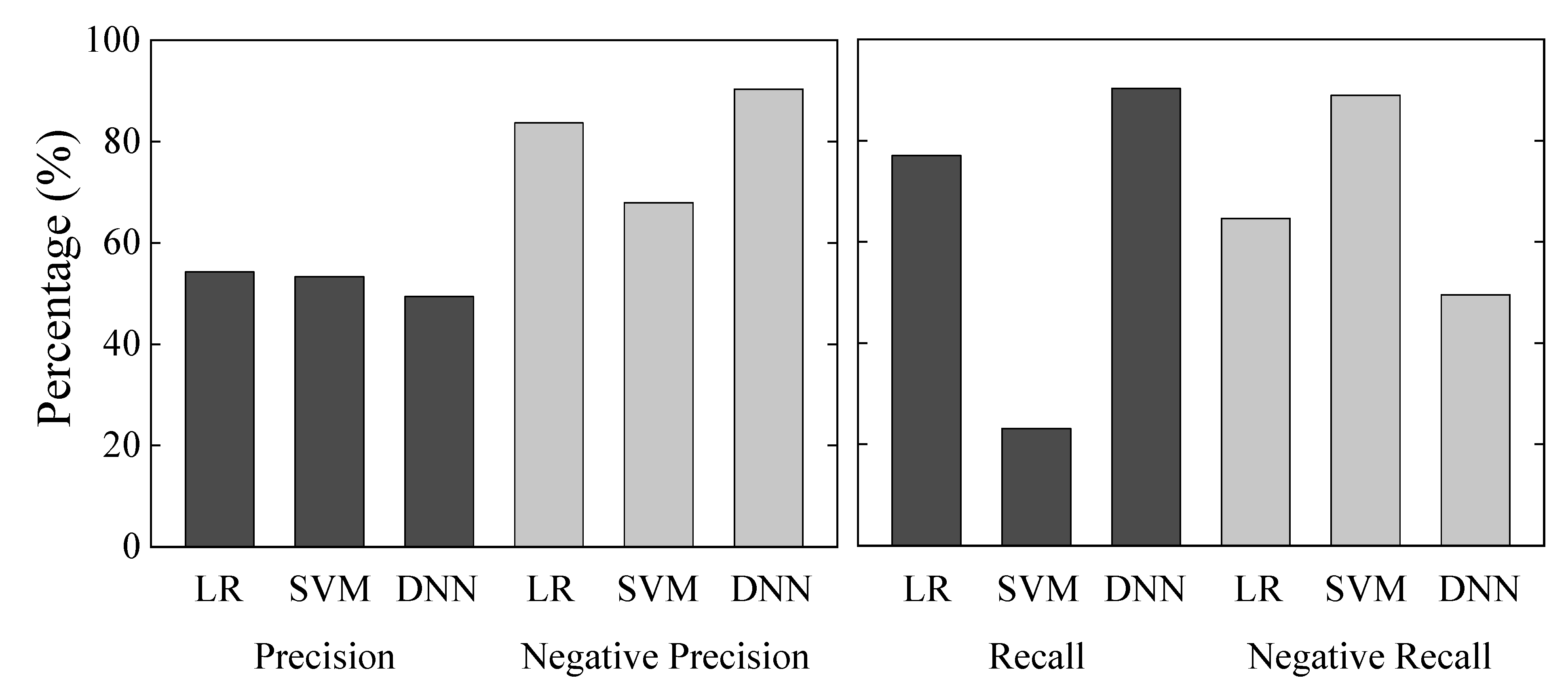
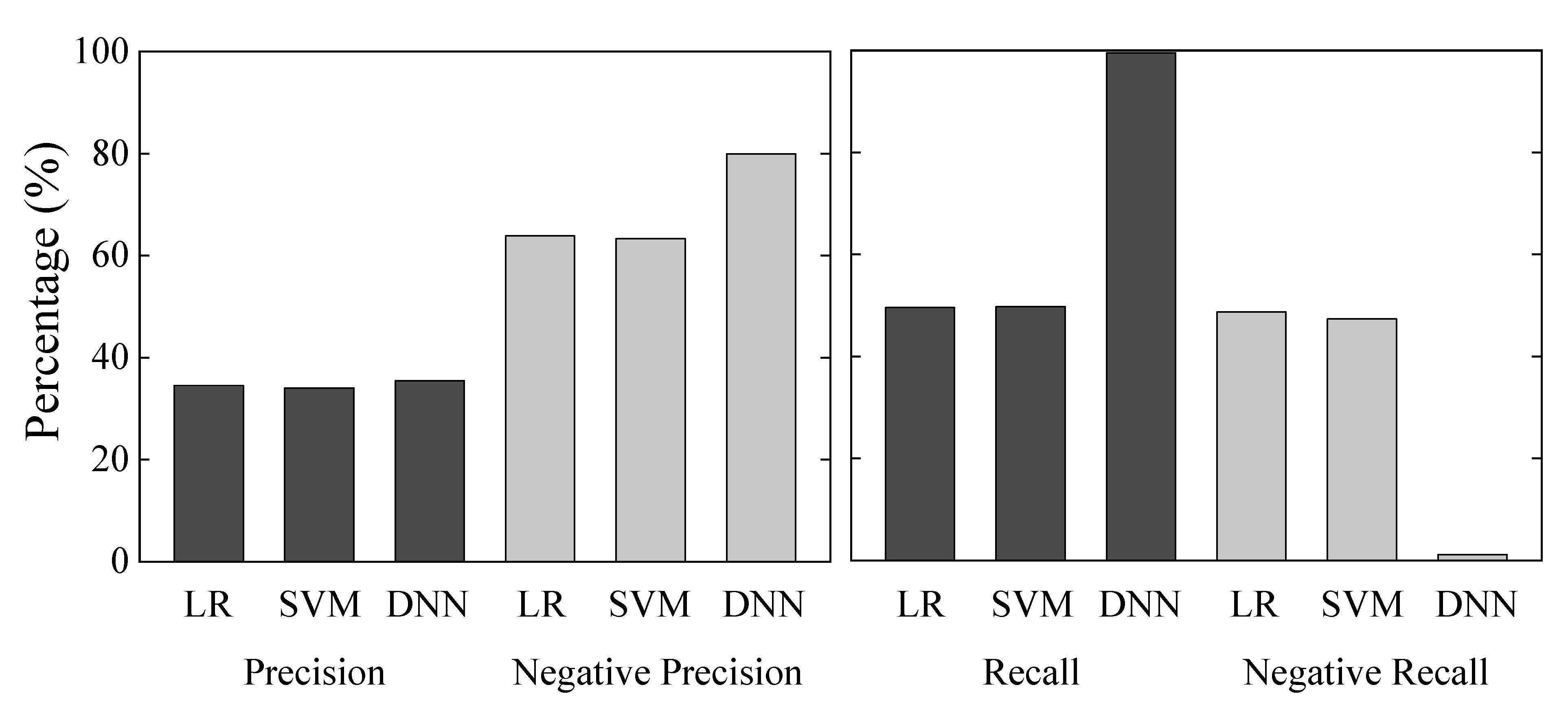
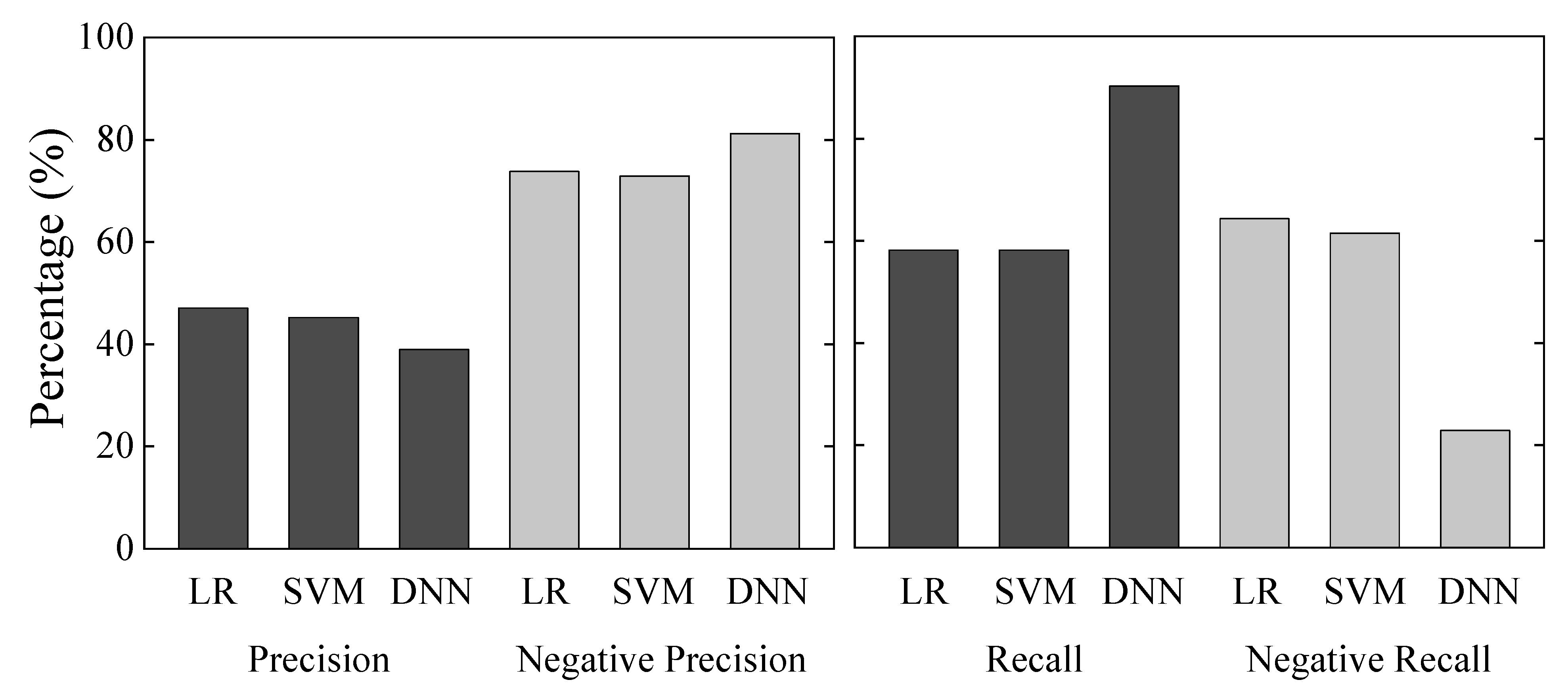
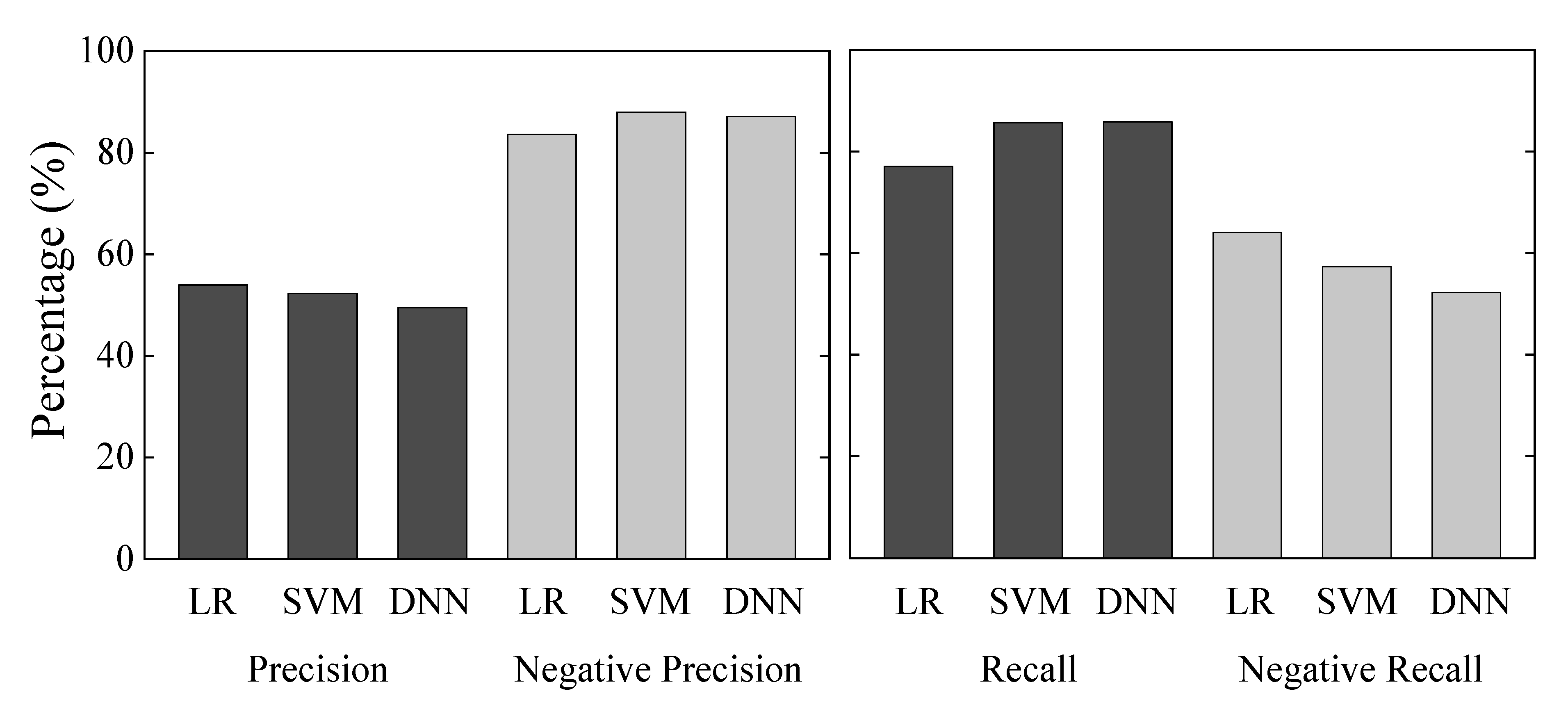
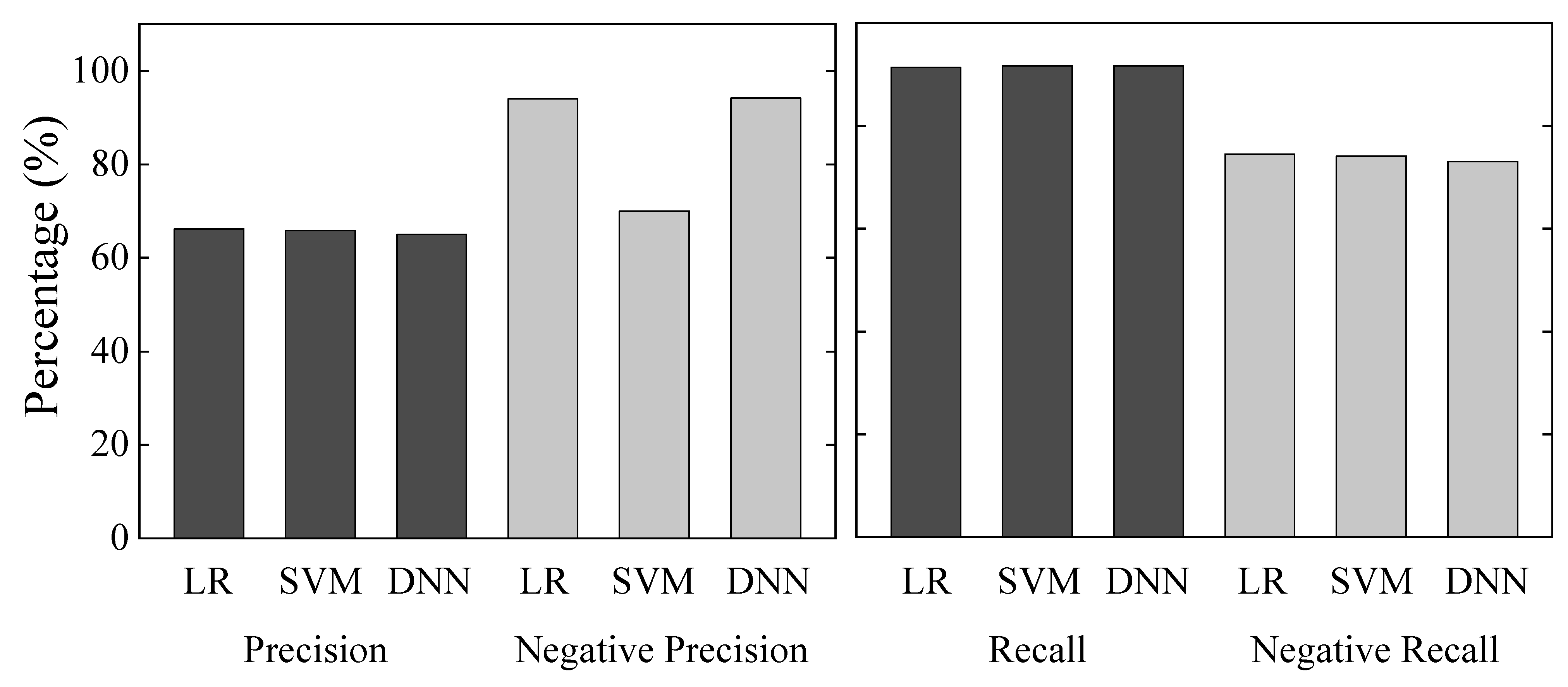
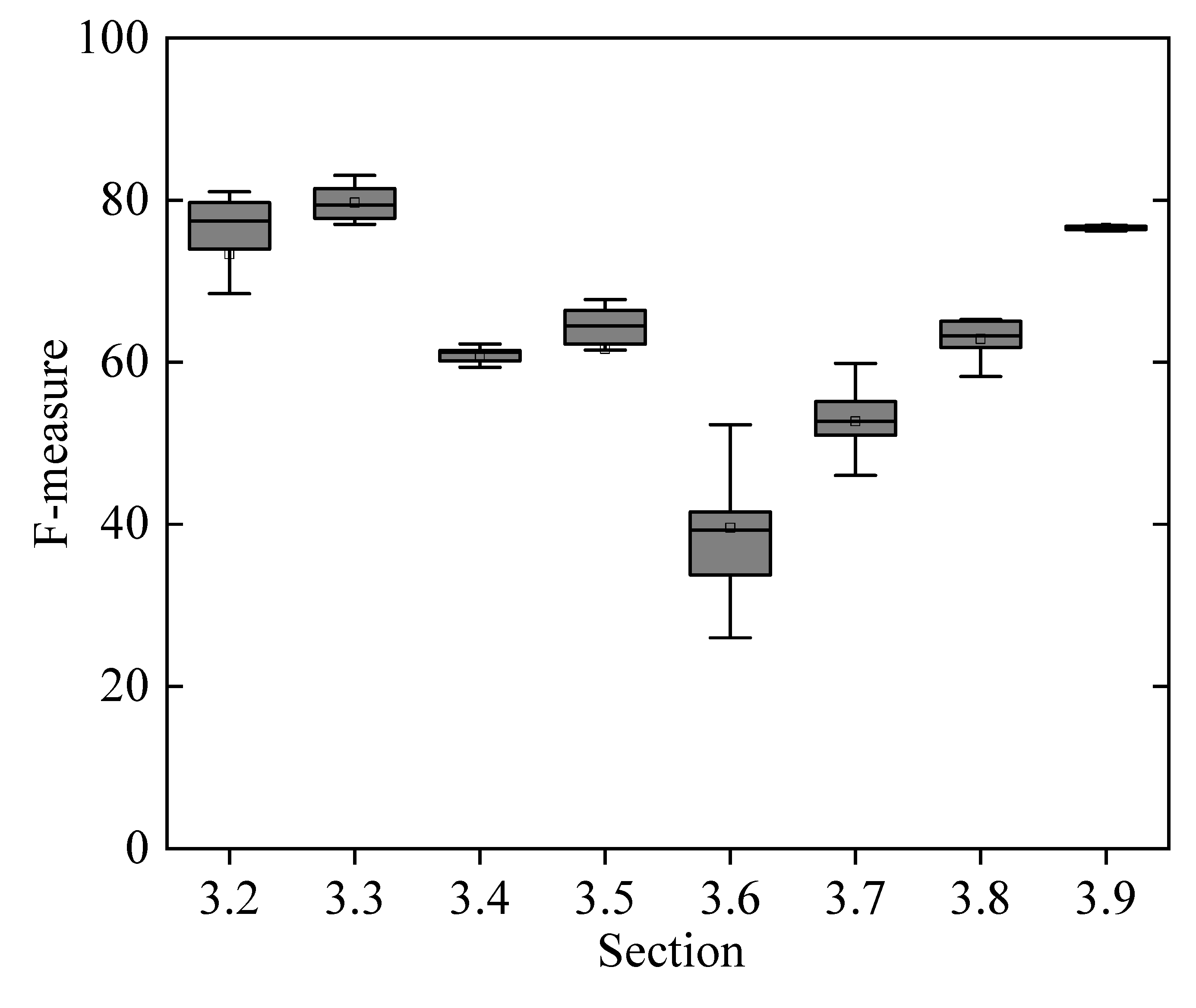

| Parameter | Instrument | Resolution | Accuracy | Manufacturer |
|---|---|---|---|---|
| Air temperature | Thermo Recorder TR-71 | 0.1 °C | ±0.3 °C | T&D Corporation |
| Air temperature | Thermo Recorder TR-72 | 0.1 °C | ±0.3 °C | |
| Relative humidity | 1% | ±5% | ||
| Globe temperature | Globe Thermometer 150 mm φ | – | – | SIBATA |
| Question | Scale |
|---|---|
| Thermal sensation | −4: Very cold; −3: Cold; −2: Cool; −1: Slightly cool; 0: Neutral +1: Slightly warm; +2: Warm; +3: Hot; +4: Very hot |
| Thermal conscious | 0: Unconscious; 1: Conscious |
| Thermal acceptability | 0: Unacceptable; 1: Acceptable |
| Thermal tolerance | 0: Intolerable; 1: Tolerable |
| Affective assessment | 1: Extremely uncomfortable; 2: Very uncomfortable 3: Uncomfortable; 4: Slightly uncomfortable; 5: Comfortable |
| Thermal preference | 1: Cooler; 2: No change; 3: Warmer |
| Machine Learning Model | Hyperparameters |
|---|---|
| NB | None |
| LR | Solver = auto, Reproducible = false, Use regularization = false, Standardize = true, Non-negative coefficients = false, Add intercept = true, Compute p-values = true, Remove collinear columns = true, Missing values handlings = Maloperation, Max iterations = 0, Max runtime seconds = 0 |
| DT | Criterion = gain ratio, Maximal depth = 10, Apply pruning = true, Confidence = 0.1, Apply prepruning = true, Minimal gain = 0.01, Minimal leaf size = 2, Minimal size for split = 4, Number of prepruning alternatives = 3 |
| RF | Number of trees = 100, Criterion = gain ratio, Maximal depth = 10, Apply pruning = false, Apply prepruning = false, Random splits = false, Guess subset ratio = true, Voting strategy = confidence vote, Use local random seed = false, Enable parallel execution = true |
| GBDT | Number of trees = 50, Reproducible = false, Maximal depth = 5, Min rows = 10.0, Min split improvement = 1.0 × 10−5, Number of bins = 20, Learning rate = 0.01, Sample rate = 1.0, Distribution = auto, Early stopping = false, Max runtime seconds = 0 |
| GPR | Kernel type = rbf, Kernel length scale = 3.0, Maxbasis vectors = 100, Epsilon tol = 1.0 × 10−7, Geometrical tol = 1.0 × 10−7 |
| SVM | Kernel type = dot, Kernel cache = 200, C = 0.0, Convergence epsilon = 0.001, Max iterations = 100,000, Scale = true, L pos = 1.0, L neg = 1.0, Epsilon = 0.0, Epsilon plus = 0.0, Epsilon minus = 0.0, Balance cost = false, Quadratic loss pos = false, Quadratic loss neg = false |
| MLP | Training cycles = 10, Number of generations = 10, Number of ensemble mlps = 4 |
| NN | Hidden layers = 2, Training cycles = 200, Learning rate = 0.01, Momentum = 0.9, Decay = false, Shuffle = true, Normalize = true, Error epsilon = 1.0 × 10−4, Use local random seed = false |
| DNN | Activation = rectifier, Hidden layer sizes = 50, Reproducible = true, Epochs = 10.0, Compute variable importances = false, Train samples per iteration = −2, Adaptive rate = true, Epsilon = 1.0 × 10−8, Rho = 0.99, Standardize = true, L1 = 1.0 × 10−5, L2 = 0.0, max w2 = 10.0, Loss function = auto, Early stopping = false, Missing values handling = meanlmputation, Max runtime seconds = 0 |
| Predicted Class | |||
|---|---|---|---|
| Positive | Negative | ||
| Actual Class | Positive | True Positive (TP) | False Negative (FN) |
| Negative | False Positive (FP) | True Negative (TN) | |
| Unit | Mean | S.D. | Median | |
|---|---|---|---|---|
| Indoor air temperature | °C | 29.1 | 2.0 | 29 |
| Indoor relative humidity | % | 63.2 | 10.2 | 63 |
| Indoor air velocity | m/s | 0.1 | 0.0 | 0.1 |
| Globe temperature | °C | 28.9 | 1.9 | 28.9 |
| Wet-bulb temperature | °C | 23.5 | 2.5 | 24.1 |
| Dew point temperature | °C | 21.1 | 3.4 | 21.9 |
| Foot temperature | °C | 28.4 | 2.0 | 28.4 |
| Outdoor air temperature | °C | 28.8 | 2.5 | 28.5 |
| Outdoor relative humidity | % | 69.7 | 12 | 70 |
| Outdoor air velocity | m/s | 2.4 | 1.3 | 2.1 |
| Atmospheric pressure | hPa | 1012.6 | 4.1 | 1012 |
| Cloud cover | – | 6.7 | 2.5 | 6 |
| Operative temperature | °C | 29 | 1.9 | 29 |
| Neutral temperature | °C | 27.2 | 2.4 | 27.1 |
| WBGT | °C | 25.1 | 2.2 | 25.6 |
| ET * | °C | 29.2 | 2.0 | 29.3 |
| SET * | °C | 25.1 | 3.4 | 24.7 |
| MRT | °C | 28.9 | 1.9 | 28.9 |
| 30-WBGT | °C | 4.9 | 2.2 | 4.4 |
| Tdiff | °C | 1.9 | 2.5 | 1.9 |
| Metabolic rate | met | 1.3 | 0.4 | 1.0 |
| Clothing insulation | clo | 0.43 | 0.2 | 0.39 |
| Proportion (%) | |||
|---|---|---|---|
| Thermal sensation | Cool | Neutral | Warm |
| 2.1 | 68.7 | 29.2 | |
| Thermal conscious | Unconscious | Conscious | |
| 47.6 | 52.4 | ||
| Thermal acceptability | Unacceptable | Acceptable | |
| 14.4 | 85.6 | ||
| Thermal tolerance | Intolerable | Tolerable | |
| 12.4 | 87.6 | ||
| Affective assessment | Uncomfortable | Comfortable | |
| 23.0 | 77.0 | ||
| Thermal preference | Cooler | No change | Warmer |
| 56.0 | 42.5 | 1.5 | |
| Features | ||
|---|---|---|
| Thermal environmental data | Indoor | Indoor air temperature, indoor relative humidity, indoor air velocity, globe temperature, wet bulb temperature, dew-point temperature, foot temperature |
| Outdoor | Outdoor air temperature, outdoor relative humidity, outdoor air velocity, atmospheric pressure, cloud cover | |
| Thermal comfort indices | Operative temperature, neutral temperature, WBGT, ET *, SET *, MRT, 30-WBGT, Tdiff | |
| Subjective vote | Thermal sensation, thermal conscious, thermal acceptability, thermal tolerance, Affective assessment, thermal preference | |
| Human factor | Gender, age, metabolic rate, clothing insulation | |
| Adaptation | Cooling, fan | |
| Other | Date/time |
| Model | Accuracy (%) | Precision (%) | Recall (%) | F-Measure (%) |
|---|---|---|---|---|
| NB | 72.6 | 57.9 | 83.8 | 68.5 |
| LR | 81.2 | 67.9 | 88.9 | 77.0 |
| DT | 80.3 | 66.0 | 91.8 | 76.7 |
| RF | 81.3 | 67.0 | 93.2 | 77.9 |
| GBDT | 84.3 | 73.9 | 86.5 | 79.7 |
| GPR | 79.1 | 66.0 | 84.0 | 74.0 |
| SVM | 69.4 | 65.8 | 27.7 | 38.9 |
| MLP | 83.9 | 72.9 | 87.3 | 79.4 |
| NN | 84.7 | 76.6 | 86.0 | 81.1 |
| DNN | 84.6 | 73.9 | 88.0 | 80.3 |
| Feature | NB | LR | DT | RF | GBDT | GPR | SVM | MLP | NN | DNN |
|---|---|---|---|---|---|---|---|---|---|---|
| Indoor air temperature | ● | ● | ● | ● | ● | |||||
| Indoor relative humidity | ● | ● | ● | ● | ● | |||||
| Indoor air velocity | ● | ● | ● | |||||||
| Globe temperature | ● | ● | ● | ● | ● | |||||
| Wet-bulb temperature | ● | ● | ● | ● | ||||||
| Dew point temperature | ● | ● | ● | ● | ||||||
| Foot temperature | ● | ● | ● | ● | ● | |||||
| Outdoor air temperature | ● | ● | ● | ● | ||||||
| Outdoor relative humidity | ● | ● | ● | ● | ||||||
| Outdoor air velocity | ● | ● | ● | |||||||
| Atmospheric pressure | ● | ● | ● | ● | ||||||
| Cloud cover | ● | ● | ● | ● | ||||||
| Operative temperature | ● | ● | ● | ● | ● | |||||
| Neutral temperature | ● | ● | ● | ● | ||||||
| WBGT | ● | ● | ● | |||||||
| ET * | ● | ● | ● | ● | ||||||
| SET * | ● | ● | ● | ● | ● | |||||
| MRT | ● | ● | ||||||||
| 30-WBGT | ● | ● | ● | |||||||
| Tdiff | ● | ● | ● | ● | ● | ● | ||||
| Thermal sensation | ● | ● | ● | |||||||
| Thermal conscious | ● | ● | ● | ● | ● | ● | ||||
| Thermal acceptability | ● | ● | ● | ● | ● | ● | ● | |||
| Thermal tolerance | ● | ● | ● | ● | ● | ● | ● | |||
| Affective assessment | ● | ● | ||||||||
| Thermal preference | ● | ● | ● | ● | ● | ● | ● | |||
| Gender | ● | ● | ● | ● | ● | ● | ● | ● | ● | ● |
| Age | ● | ● | ● | ● | ● | |||||
| Metabolic rate | ● | ● | ● | ● | ● | ● | ● | |||
| Clothing insulation | ● | ● | ● | ● | ● | ● | ||||
| Cooling | ● | ● | ● | ● | ● | ● | ● | ● | ● | ● |
| Fan | ● | ● | ● | ● | ● | ● | ● | |||
| Date/time | ● | ● | ● | ● | ● | ● | ● |
| Model | Accuracy (%) | Precision (%) | Recall (%) | F-Measure (%) |
|---|---|---|---|---|
| NB | 81.0 | 67.5 | 89.8 | 77.0 |
| LR | 81.7 | 68.4 | 90.1 | 77.8 |
| DT | 81.9 | 68.5 | 90.9 | 78.1 |
| RF | 84.4 | 71.5 | 93.0 | 80.9 |
| GBDT | 84.5 | 73.0 | 89.4 | 80.4 |
| GPR | 82.8 | 71.2 | 87.1 | 78.3 |
| SVM | 80.7 | 66.6 | 91.7 | 77.2 |
| MLP | 86.8 | 76.6 | 90.6 | 83.1 |
| NN | 87.0 | 78.1 | 88.3 | 82.9 |
| DNN | 85.2 | 73.8 | 90.8 | 81.4 |
| Model | Accuracy (%) | Precision (%) | Recall (%) | F-Measure (%) |
|---|---|---|---|---|
| NB | 67.5 | 53.3 | 67.3 | 59.5 |
| LR | 67.2 | 52.8 | 67.8 | 59.4 |
| DT | 56.1 | 44.8 | 91.6 | 60.2 |
| RF | 64.1 | 49.6 | 83.7 | 62.3 |
| GBDT | 60.9 | 47.1 | 88.0 | 61.4 |
| GPR | 64.9 | 50.3 | 79.0 | 61.4 |
| SVM | 65.9 | 51.3 | 73.6 | 60.5 |
| MLP | 64.4 | 50.1 | 80.3 | 61.7 |
| NN | 63.9 | 49.5 | 81.0 | 61.5 |
| DNN | 60.2 | 46.7 | 88.5 | 61.1 |
| Model | Accuracy (%) | Precision (%) | Recall (%) | F-Measure (%) |
|---|---|---|---|---|
| NB | 68.7 | 54.7 | 72.2 | 62.2 |
| LR | 69.0 | 54.3 | 77.0 | 63.7 |
| DT | 60.2 | 46.9 | 89.4 | 61.5 |
| RF | 66.1 | 51.2 | 88.9 | 65.0 |
| GBDT | 69.4 | 54.2 | 89.0 | 67.4 |
| GPR | 72.3 | 57.6 | 82.2 | 67.8 |
| SVM | 65.7 | 53.3 | 23.5 | 32.6 |
| MLP | 69.8 | 55.4 | 82.0 | 66.1 |
| NN | 70.3 | 55.5 | 82.8 | 66.4 |
| DNN | 63.9 | 49.6 | 90.3 | 64.0 |
| Model | Accuracy (%) | Precision (%) | Recall (%) | F-Measure (%) |
|---|---|---|---|---|
| NB | 55.4 | 35.4 | 32.2 | 33.7 |
| LR | 49.0 | 34.4 | 49.5 | 40.6 |
| DT | 58.0 | 34.4 | 20.9 | 26.0 |
| RF | 58.6 | 38.6 | 30.0 | 33.8 |
| GBDT | 42.4 | 36.7 | 87.4 | 51.7 |
| GPR | 55.3 | 37.4 | 38.1 | 37.7 |
| SVM | 48.2 | 33.5 | 49.8 | 40.1 |
| MLP | 49.1 | 34.9 | 51.3 | 41.5 |
| NN | 51.1 | 34.6 | 43.4 | 38.5 |
| DNN | 35.9 | 35.5 | 99.5 | 52.3 |
| Model | Accuracy (%) | Precision (%) | Recall (%) | F-Measure (%) |
|---|---|---|---|---|
| NB | 58.1 | 42.9 | 57.5 | 49.1 |
| LR | 62.2 | 47.4 | 58.2 | 52.2 |
| DT | 61.0 | 47.7 | 44.5 | 46.0 |
| RF | 56.7 | 43.2 | 64.5 | 51.8 |
| GBDT | 58.9 | 45.9 | 85.8 | 59.8 |
| GPR | 62.4 | 47.8 | 65.2 | 55.2 |
| SVM | 60.3 | 45.4 | 58.2 | 51.0 |
| MLP | 61.4 | 47.2 | 62.3 | 53.7 |
| NN | 60.9 | 46.6 | 61.9 | 53.2 |
| DNN | 46.7 | 39.7 | 90.3 | 55.2 |
| Model | Accuracy (%) | Precision (%) | Recall (%) | F-Measure (%) |
|---|---|---|---|---|
| NB | 67.0 | 52.5 | 65.3 | 58.2 |
| LR | 68.7 | 54.2 | 77.0 | 63.6 |
| DT | 54.9 | 43.8 | 93.5 | 59.6 |
| RF | 61.9 | 47.9 | 87.3 | 61.8 |
| GBDT | 63.3 | 49.0 | 86.2 | 62.5 |
| GPR | 68.2 | 53.2 | 84.0 | 65.2 |
| SVM | 67.3 | 52.5 | 85.6 | 65.1 |
| MLP | 68.2 | 53.4 | 83.8 | 65.3 |
| NN | 66.5 | 51.6 | 86.2 | 64.6 |
| DNN | 64.1 | 49.7 | 85.8 | 62.9 |
| Model | Accuracy (%) | Precision (%) | Recall (%) | F-Measure (%) |
|---|---|---|---|---|
| NB | 80.5 | 66.2 | 91.8 | 76.9 |
| LR | 80.3 | 66.0 | 91.8 | 76.8 |
| DT | 80.1 | 66.0 | 90.5 | 76.3 |
| RF | 79.8 | 65.4 | 91.2 | 76.2 |
| GBDT | 79.8 | 65.3 | 91.9 | 76.4 |
| GPR | 80.2 | 65.9 | 91.6 | 76.6 |
| SVM | 80.3 | 66.0 | 91.8 | 76.8 |
| MLP | 80.3 | 65.9 | 91.8 | 76.7 |
| NN | 80.3 | 66.0 | 91.8 | 76.8 |
| DNN | 80.0 | 65.6 | 91.6 | 76.5 |
Publisher’s Note: MDPI stays neutral with regard to jurisdictional claims in published maps and institutional affiliations. |
© 2022 by the authors. Licensee MDPI, Basel, Switzerland. This article is an open access article distributed under the terms and conditions of the Creative Commons Attribution (CC BY) license (https://creativecommons.org/licenses/by/4.0/).
Share and Cite
Furuhashi, K.; Nakaya, T.; Maeda, Y. Prediction of Occupant Behavior toward Natural Ventilation in Japanese Dwellings: Machine Learning Models and Feature Selection. Energies 2022, 15, 5993. https://doi.org/10.3390/en15165993
Furuhashi K, Nakaya T, Maeda Y. Prediction of Occupant Behavior toward Natural Ventilation in Japanese Dwellings: Machine Learning Models and Feature Selection. Energies. 2022; 15(16):5993. https://doi.org/10.3390/en15165993
Chicago/Turabian StyleFuruhashi, Kaito, Takashi Nakaya, and Yoshihiro Maeda. 2022. "Prediction of Occupant Behavior toward Natural Ventilation in Japanese Dwellings: Machine Learning Models and Feature Selection" Energies 15, no. 16: 5993. https://doi.org/10.3390/en15165993
APA StyleFuruhashi, K., Nakaya, T., & Maeda, Y. (2022). Prediction of Occupant Behavior toward Natural Ventilation in Japanese Dwellings: Machine Learning Models and Feature Selection. Energies, 15(16), 5993. https://doi.org/10.3390/en15165993







